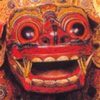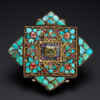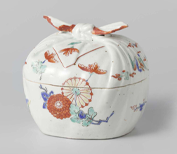LOUIS NG
Director of Hong Kong Palace Museum

IN 1420, THE HISTORY of the Forbidden City began when the Yongle emperor (reigned 1402–1424) announced the movement of the capital to Beijing, where the newly constructed palace complex was located. Built on the city’s central axis, the position of the Forbidden City testified to its significance to Chinese politics and culture (1). It served as both the political centre of China and main residence of the imperial household during the Ming (1368–1644) and Qing (1644–1911) dynasties, witnessing the prosperity and decline of families and empires. In 1925, this complex was turned into the Palace Museum, which today houses over 1.8 million works of art and plays an active role in promoting dialogue between China and the world.

I was nineteen years old when I set foot in the Palace Museum for the first time. The Forbidden City captivated me with its awe-inspiring grandeur and solemn beauty. Thereafter, I visited it on every trip to Beijing. At the time, the train ride from Hong Kong took almost forty hours. The Palace Museum felt so distant and yet so close. I certainly did not expect then that four decades later, Hong Kong would be home to its own Palace Museum, and that I would have the honour of becoming its inaugural director (2).

The establishment of the Hong Kong Palace Museum (HKPM) was formally launched in June 2017, and after five years in the making, the museum is set to open in July 2022 (3). A collaborative project between the Palace Museum and the West Kowloon Cultural District Authority, it is a critical part of one of the largest cultural infrastructure projects in the world, which offers world-class integrated arts and cultural facilities—including M+, a global museum of contemporary visual culture that opened in November 2021. The development of the museum project has been made possible by the generous support of the Chinese Central Government, the Hong Kong Special Administrative Region Government, and public-spirited organisations and individuals, who share the goal of enriching the cultural landscape of Hong Kong and sharing the wealth and breadth of traditional Chinese culture.
Embracing novel curatorial approaches, this new museum aspires to become one of the world’s leading cultural institutions committed to the study and appreciation of Chinese art and culture, while advancing dialogue between different countries. It will offer a Hong Kong perspective and a global vision, presenting the finest objects from the Palace Museum and other important cultural institutions from around the world. Through innovative research, travelling exhibitions, and educational, cultural and professional exchange programmes, it will also build international partnerships and help position Hong Kong as a global hub for art and cultural exchange.


Over 900 objects from the Palace Museum’s collection have been carefully selected for display in the museum’s opening exhibitions. Focusing on diverse themes, that include architectural art, court life, craftsmanship, and collections of bronzes, ceramics, paintings, and calligraphy, a loan of this size is unprecedented in the history of the Palace Museum, and signifies the strategic partnership between the two institutions. Many of these treasures will be exhibited in Hong Kong for the first time, while others have never been displayed to the public—offering a cultural feast for both the people of Hong Kong and international audiences.

The loans will be displayed across nine galleries, five of which are discussed in this special issue of Arts of Asia. Five of the galleries host thematic exhibitions, which introduce aspects of the fascinating history and culture of the Forbidden City through exceptional works from its collection (4, 5, 6). Two other galleries feature art collections in Hong Kong and multimedia projects (7, 8). The final two are devoted to special exhibitions organised by the museum or presented in partnership with other institutions, such as the Louvre Museum, Paris (9, 10). The HKPM has also received commitments of major donations from several private collections, which will foster a culture of collaboration and donation at the museum and allow it to take its place among several other important art institutions in Hong Kong. They will also provide an important foundation for original exhibitions and academic research.


Beyond our exhibitions, the museum is set to become an innovative leader in museum education through developing fresh content, creative programming, new technologies, and partnerships with local and global stakeholders. The museum’s educational programmes are divided into three key areas: the Palace Academy, school partnerships and community engagement. At 1600 square metres, the Palace Academy is the largest dedicated museum learning space in Hong Kong. It will provide a wide range of educational activities, including film screenings, public lectures, student exhibitions, workshops, and courses on Chinese art, history and culture.


These exhibitions and educational programmes will be housed in a state-of-the-art building designed by Rocco Design Architects Associates Ltd, responsible for several award-winning buildings in Hong Kong, such as One Peking Road and Three Garden Road, Central, as well as the Yunnan Museum and Guangdong Museum in China. A fresh and contemporary interpretation of traditional aesthetics, it draws inspiration from both historical Chinese art and architecture and Hong Kong’s urban environment. Three atriums will connect the different floors of the museum vertically, referencing the horizontal spatial configuration of the Forbidden City’s central axis (11). In the atriums, visitors can enjoy vistas of the Museum Plaza, the Hong Kong Island skyline and Lantau Island, while appreciating the harmony between the museum building and its surroundings (12).

As a new Palace Museum in China, one of the key considerations in developing the HKPM has been how to differentiate it from its counterparts in Beijing and Taipei in terms of vision and positioning. I have proposed the idea of a “connected museum” to capture the distinct identity and role the museum will play in advocating a new paradigm for the interpretation of Chinese art and culture. In this context, the concept of connection has multiple meanings.
First, the HKPM will connect the past to the present, helping us understand who we are and how we came to be. It will not be a shrine containing works of art for people to worship. Instead, it will provide contemporary connections to works of art and historical objects in relation to modern life. Through storytelling, the museum will spark interest, encourage audiences to explore and contemplate, create meaning by connecting the objects on display to lived experiences, and help visitors internalise the history and culture of the Palace Museum. By providing this modern-day connection, the museum will serve as a catalyst for creativity and a place to bring traditional Chinese art and history into our modern lives.

The second connection is hyperconnectivity. Digital culture and technology are changing the way we experience and consume content, as well as the ways in which we interact with one another. As a forward-looking museum, the HKPM is committed to collaborating closely with artists, educators, designers, and the creative and technology sectors to open up new ways of learning and experiencing art and culture. The museum will do this through cultivating immersive storytelling, creating a digitally embedded museum environment, and engaging with many forms of digital content (13). We will tap into the enormous potential of digital technology and social media to engage with new audiences, explore collections in a new light, transform online learning, and, ultimately, rethink the entire visitor experience. This will enable us to meet the societal challenges of a networked and mediated culture more effectively.
The HKPM will also strengthen its connections with Chinese museums and audiences, leveraging Hong Kong’s deeper integration within the overall development strategy of the country. Strategic partnerships will be established with major Chinese museums for the purpose of collaboration and resource sharing, which will have mutual benefits. Cultural resources, drawn from our partnering museums, will be capitalised on to help students and young people in Hong Kong better understand Chinese history and culture, which will help forge a sense of national identity. The museum will also take advantage of the developmental opportunities of the Guangdong – Hong Kong – Macau Greater Bay Area. With a population of over 72 million, this region has huge market potential, presenting opportunities for the museum to expand its audience base and promote patronage. The museum, in turn, will promote mutual trust and understanding within the Greater Bay Area as we work towards a shared vision and set of values.

Finally, the museum aspires to connect Chinese culture with a global audience. We are well positioned to play a key role in supporting Hong Kong’s efforts to become an art and culture hub, forming a bridge between China and the rest of the world. It will further international co-operation through strategic cultural partnerships, travelling exhibitions on world civilisations, collaborative research and professional training programmes. The museum is already well on its way to this, having reached out to over seventy major museums around the world in the interests of establishing a robust international network of partners. The museum’s multicultural team comprises distinguished scholars and curators with diverse cultural backgrounds. They are well suited to overcoming language and cultural barriers when communicating with international audiences, which will make the museum’s exhibitions and other offerings more engaging, inclusive and accessible to all.
Ultimately, as a world-class institution, the museum is at heart a cultural resource that belongs to the community of Hong Kong. As a dynamic platform, it will inspire community engagement, foster dialogue and partnerships, and promote creativity and interdisciplinary collaboration. Our goal is to give our visitors a glimpse of the vastness and kaleidoscopic nature of the Palace Museum collection, as well as the richness of Chinese culture. More than an assemblage of treasures, we hope that it will serve a collection of intimate and informative stories about the people, objects, places and experiences that make up the rich history of China, suitable for young and old, amateurs and experts alike.

 Subscribe
Subscribe Calendar
Calendar Links
Links Gift
Gift


